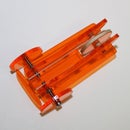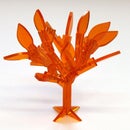Introduction: 2 Meter Flying RC Starship Enterprise
It's not a representation of a particular version of the Enterprise, but an "artist's impression" of the yet unappeared Enterprise Z (Z from Zeppelin) .
Check out the video to see how it moves around:
I made it for the occasion of the BVC participation at the 20th F.A.C.T.S. convention in Ghent, October 23-24, 2010. The BVC or Belgian Voyage Club is the Belgian Star Trek fan club (www.bvc.be). And it's flying again at the 21st F.A.C.T.S. convention in Ghent, October 22-23, 2011.
In this Ible I explain how I made the construction. I also explain the main principles of the build of a vectored thrust propulsion (propellers moving in the direction you want thrust) and tail motor steering. The exact solution is however depending on what RC-components you have available.
Thanks for the votes in the Autodesk Kinetic Sculpture Design Contest!
Step 1: Materials
It is quite possible to make blimp envelopes yourself, but I never reached the helium tightness of industrially made balloons. Also the “valve” used by commercial balloons is hard to match in ease of use and tightness. Therefore I based my project on ready made balloons:
Two Zeppelin NT foil balloons, available at the webshop from the Deutsche Zeppelin Reederei.
A 52” blimp envelope, as common for toy RC Blimps. I actually used a 52” x 37” version with extra load bearing capacity. This allowed to add more trimming weight and removing it to compensate for helium loss over time.
A 36 or 38” round foil balloon (as sold for toy RC “flying saucer” blimps or large decorative balloons).
About 2 to 3 m2 of balloon foil (I used a type with one side in white, matching the main hull, but a silver coloured Enterprise Z would look great too).
The last to items could be replaced by an "Amazing Indoor Anti-Gravity Flying Disc", if you can find one.
Similar flying discs are available, but these are smaller and come in colourfull prints not suited for this project.
99%+ pure helium for maximum buoyancy. For small quantities I find it cheapest and easiest to have my balloons filled at the local balloon shop. Balloon Surprise in Drongen gives excellent service.
Construction material:
Some extruded polystyrene sheet (mostly known under the brand name “Depron”, about 0.5 m2 of 5-6 mm thickness and 0.5 m2 of 3 mm thickness.
about 3.5 m of 2 mm diameter glassfiber composite rod (as available from kite shops) or, even probably better probably about 1.5mm carbon composite rod.
Polystyrene contact glue. The clear type is preferred, but as I didn't have that available some camouflaging was done at the end with white acrylic paint.
Some superglue
Clear cellotape, wide and standard
Thin double sided tape (the carpet fixing type).
A printer and paper (as light as your printer accepts is best, but I used ordinary office paper)
About 50g of plasticine as trimming weight (no play dough, as this tends to dry out and lose weight)
Propulsion and control:
The propulsion and RC components should be under 40g. I used an 8g parkflyer receiver, three 6g micro servos, an extra motor from such a servo, a 10g LiPo battery and three 6.5 diameter indoor airplane propellers. To that I added , two small gears with a 1 to 3 ratio (4 is even better), some 2mm diameter carbon rod (a piece of 20 cm and one of 40 cm), an a extra small micro switc and about 2.5 m of the thinnest isolated electric wire I could find.
Step 2: Building the Saucer Section
From the foil material I made a square slightly over 1m x 1m by taping two pieces together. For the second square I did not tape the two pieces together yet, but reinforced the edges to be joined later with some tape.
Spreading the first square, with the inside upwards, on a table, I fixed in place with some tape at the corners. I marked a circle a couple of cm larger than the one made from the long rods. I cut out this circle and taped the edge loosely around the rod. It should be loose to allow the saucer construction to form its shape later on. The exact fit is made by trimming the rod's circle diameter after full assembly.
Now the second square (the one made out of two parts remaining separate) was spread out and taped to the table, again with the inside on top. The circle already prepared is put over it, with the outside on top. Again the foil is marked a couple of cm outside the circle and cut. This “hem” is folded over the edge an taped on the first foil circle.
Now we have a kind of envelope in witch we put the fully inflated 36 or 38” round balloon, through the slit in one of the sides. The slit is closed with a couple of pieces of tape. Leave a part open near the valve of the inner balloon.
Now look up one of the overlap connections of the rods. Cut out some of the foil on the edge and remove the tape keeping the rods together. Adjust the tension to give the assembly the right shape and attach the rods back together. The right diameter is when the circle is large enough to give a taut shape, but the tension is not to high, avoiding a warped edge. I found it easiest to keep the rod ends together with some thin metal wire wrapped around, allowing for some slip. Then, by sliding the ends to the desired diameter, a couple of drops of superglue was added to fix them to each other.
Step 3: The Nacelle Struts
The struts themselves are made out of 6mm thick polystyrene foam sheets 12,5cm x 50 cm. One end is cut with an incline in such a way they are at the desired (right) angle when glued on the support (with contact glue). The connection is reinforced with some triangular shaped strips.
At the top end a perpendicular 3cm x 10cm x 6mm sheet rectangle is provisionary glued on the strut with a little contact glue (this is not the final joint yet).
With some double sided tape again both fully inflated nacelle is glued in place. Try to align them as good as possible, but I found I needed to partially loosen de provisionary glue joint to do the final alignment and glue everything in place.
Step 4: The Saucer Strut
A long diamond shaped piece is prepared out of 6mm foam sheet. Put it on a soft surface (e.g. a seat) and roll a bottle over it to give it a slight curvature, fitting the front top side of the hull. Stick it on the fully inflated main hull balloon, with a 4cm x 4cm piece of double sided tape on each corner.
The saucer gets a T-shaped 6mm polystyrene foam sheet attached with some double sided tape at the ends.
Carefully adjust the strut ends with a cutter knife to fit the two attachment surfaces: cut out thin layers and keep testing the fit. When both ends are prepared glue one end to the main hull foam piece.
The other side gets some 4cm x 4cm x 6mm foam pieces in the corners. Two in each. They are fixed by driving through a piece of glassfiber or carbon rod. At this stage they should stick out about a cm. These ends sticking out are glued to the saucer foam piece with contact glue. When the glue has completely set the rods are taken out. The gap is closed by sinking in the inner foam pieces in the strut, and the rods are driven through again, making new holes in the inner foam pieces. Keep the rod pieces in place with a little tape.
Step 5: Deflector Dish and Decorating
A 4cm x 4cm piece of double sided tape is used to attach the back of the dish to the main hull.
To cover the “Zeppelin NT” print on the nacelles, the “NCC-1701-Z” inscription needs to be large enough. Printing it diagonally on an A3 sheet just managed that. I used the “Enterprise” True Type Font. The inside print was covered with a cut out from some spare foil. All decorations ar stuck in place with small pieces of double sided tape.
Step 6: Propulsion Gondola With Vectored Thrust
First you need to take two very small motors. I took them from micro servos, as I needed two servo-electronics for the next step anyway.
One servo is kept complete. The larger gear is glued (centered) on a servo horn. The small gear is mounted close to the middle of the 20 cm carbon rod. With some fitting tube as bearing the rod is glued to the servo, aligned in such a way the gears match. The micro switch is glued on the servo, in such a way the servohorn can work it. The motors are glued to the rod’s end. The motors are connected in parallel to power connector matching the receiver (everything is run from the same battery, connected to the receiver).
The switch is used in such a way that in one position of the servo the motors are switch off and in all other positions they are switched on. This way you use the servo to choose to choose the direction of trust. One orientation, at neutral, is “sacrificed” for the “off” position. I usually sacrifice the position between down and back. The inertia allows to go from the off position to whatever position you want without affect of the intermediate positions.
Step 7: Steering Tail Motor
The tail motor can be controlled by the electronics of a servo. But as this tends to give “restless” neutral position I use the following trick: I connect two servo electronics in parallel. Then I connect one motor lead from one board and one from the other board to the motor. By trimming both potentiometers I get a wider neutral gap (were both boards give the same polarity out of the used motorleads).
Step 8: Attaching the Gondola, Trimming and Flying
For the best control the gondola should be under the center of gravity, or somewhat in front. As The gondola itself strongly influences the center of gravity, some testing is needed. As the saucer section has no net buoyancy, the gondola and the trimming weight needs to be fairly at the back. Therefore I put the trimming weight at the far end of the aft carbon rod, in order to be able to put the gondola less to the back. The gondola is attached with some large clear tape.
Flying the Enterprise Z clearly demonstrated why airships are not shaped like the Enterprise. In the particular convention hall with powerfull and concentrated air inlets and vents, the saucer section proved to make a stable control of the flight quite difficult. In calmer air that would have been a lot easier.




